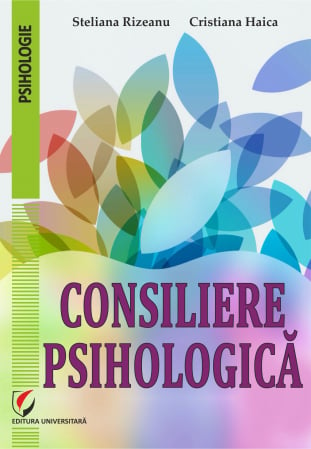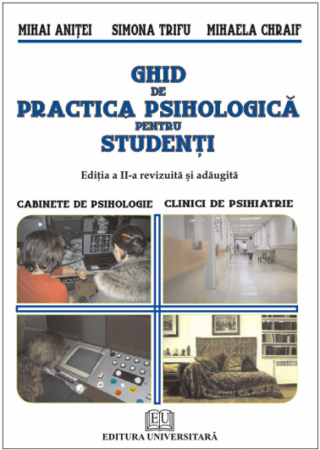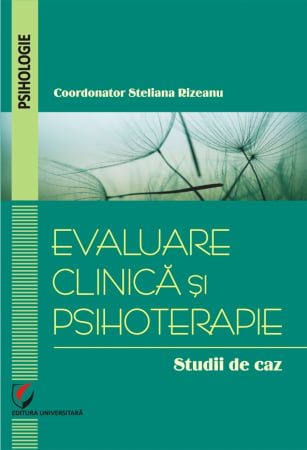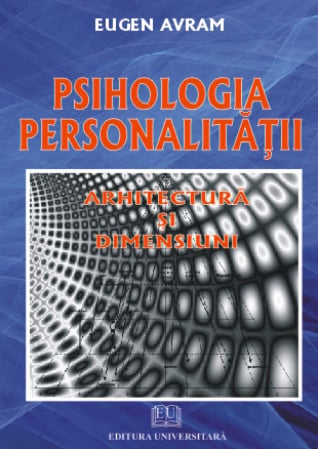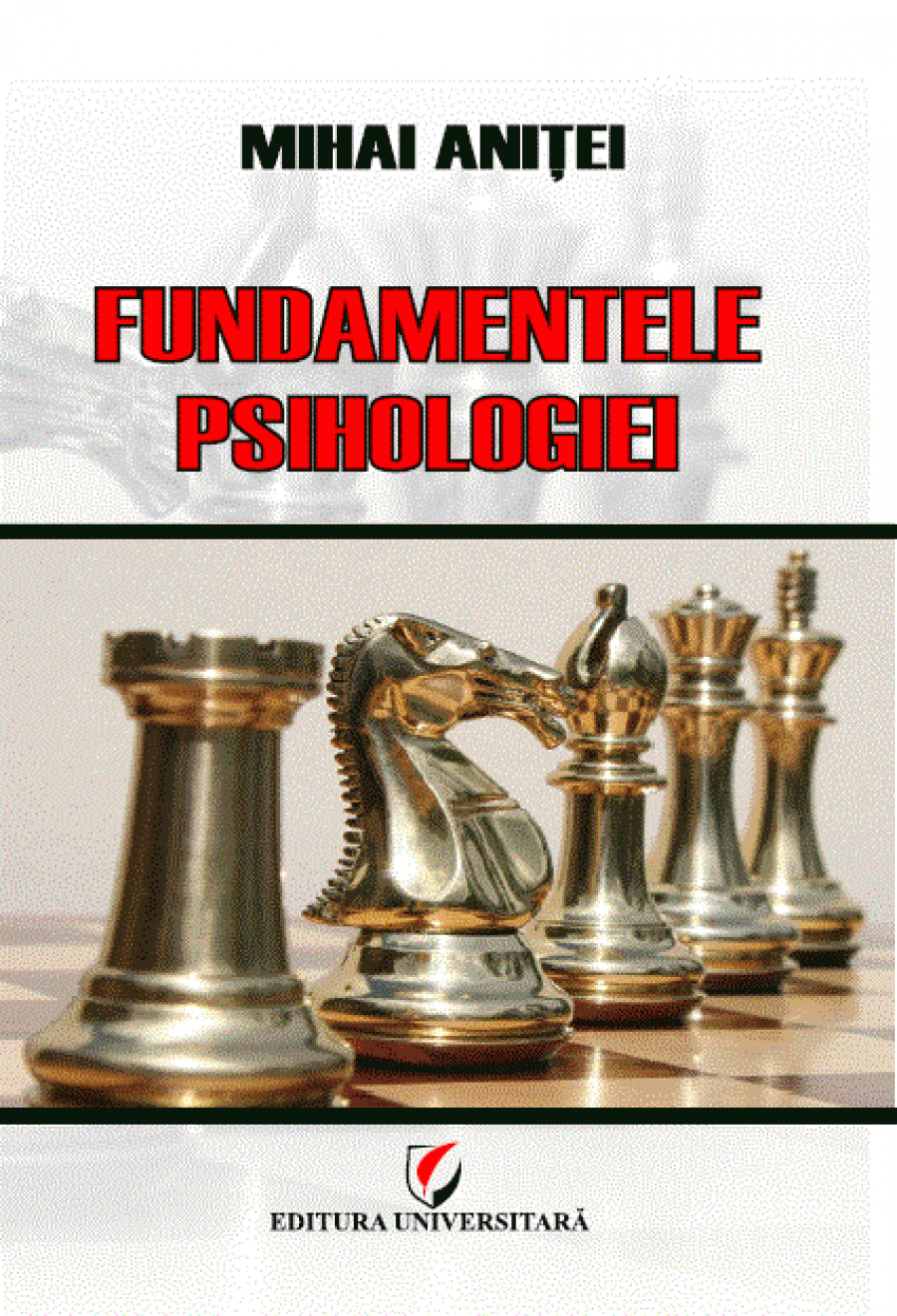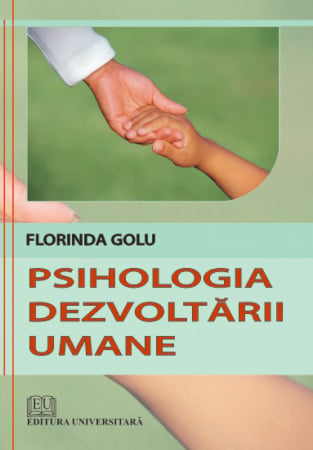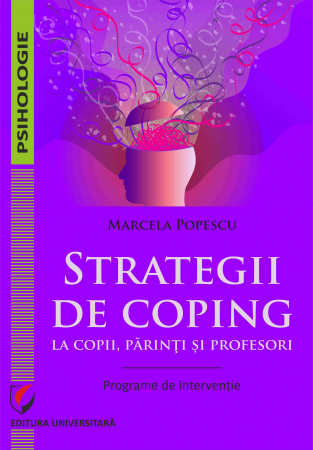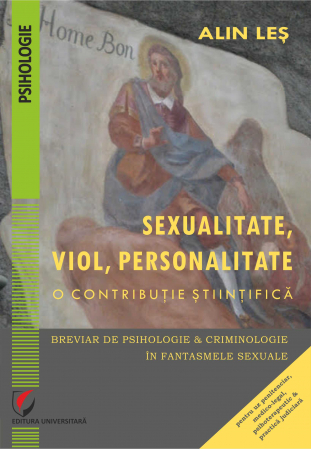Manuscript proposals: info@editurauniversitara.ro / 0745 204 115 //// Tracking orders Individuals / Sales:0745 200 718 / 0745 200 357 Orders Legal entities: 0721 722 783
ISBN: 978-606-28-1322-2
DOI: https://doi.org/10.5682/9786062813222
Publisher year: 2021
Edition: I
Pages: 246
Publisher: Editura Universitara
Author: Simona Trifu
Product Code:
9786062813222
Do you need help?
0745 200 718
/
0745 200 357
- Description
- Authors
- Content
- More details
- Where to find it
- Reviews (0)
This book is a first in Romanian psychoanalysis, being a collection of psychodynamic interpretations of works of art by painter, graphic artist and sculptor Alex Ivanov, with strict reference to the intrapsychic dynamics of the characters, as they are reflected in the analytical function of the minds of specialists. they made the interpretations.
We want a "vivisection" of an artistic world presented as alive and in dynamics, an organism in itself, in which the painter is exclusively his heart, the brain and critical thinking being of specialists in the psychoanalytic area.
The focus of the interpretive perspective was not on the inner world of the artist, but on the expression of these dimensions - either supernatural or excessive - a hyperbolization in vitality and graphic expressiveness, which raises existence to the rank of joy and virtue.
Feminine or masculine hypostases of the Self are made explicit, along with hypostases of a soul "transhumance" in potentially biblical or esoteric spaces. The paintings are designed with reference to the Law of the Father, when the painter's soul is also the honor of his profession.
The effort of the young specialists to connect emotionally to the ecstasy of art is commendable, at no moment has the existential telluric escaped, the life to which we all owe, because it is inscribed in the "roll of existence", depending on ourselves the fulfillment of the path of fulfillment.
Assoc. Dr. Simona Trifu,
psychoanalyst, full member IPA
We want a "vivisection" of an artistic world presented as alive and in dynamics, an organism in itself, in which the painter is exclusively his heart, the brain and critical thinking being of specialists in the psychoanalytic area.
The focus of the interpretive perspective was not on the inner world of the artist, but on the expression of these dimensions - either supernatural or excessive - a hyperbolization in vitality and graphic expressiveness, which raises existence to the rank of joy and virtue.
Feminine or masculine hypostases of the Self are made explicit, along with hypostases of a soul "transhumance" in potentially biblical or esoteric spaces. The paintings are designed with reference to the Law of the Father, when the painter's soul is also the honor of his profession.
The effort of the young specialists to connect emotionally to the ecstasy of art is commendable, at no moment has the existential telluric escaped, the life to which we all owe, because it is inscribed in the "roll of existence", depending on ourselves the fulfillment of the path of fulfillment.
Assoc. Dr. Simona Trifu,
psychoanalyst, full member IPA
Assoc. Dr. SIMONA TRIFU, psychoanalyst, full member IPA - Coordinator
Preface, Prof. univ. Dr. Matei Georgescu / 9
Hiroshima
Red, black and nothing else… My red voice, my black voice…, Florentina Stan / 14
Birds without sky
The flight, Edhit Sirbu / 21
Alina Nedeloiu / 24
Alexithymia
Depressive hardening phenomenology, Mirela Dinica / 29
Athimhormie
Derealization of anxiety, Mirela Dinica / 34
Mihai Gabriel Nastase / 38
My calm of great days…, Claudia Nicoleta Vija / 43
Testimonials
The interpretive parallel with the film “Noah” (2014), Simona Trifu / 46
Labor and magic…, Alexandra Nicoleta Geara / 48
From anaclitic depression to self-directed aggression and suicide (the picture as a hypostasis of an assisted parasucidal behavior), Simona Trifu / 52
My love for the truth ..., Alexandra Nicoleta Geara / 61
Vitality
Unisex portrait, Gabriela Ancuta / 65
Andreea Liliana Ilie / 66
Abandonment and the issue of attachment, Gabriela Ancuta / 70
Simona Trifu / 71
Excessive
My bouquet of roses Bacara, Simona Trifu / 75
Opioid. Opiate. Omnipotent, Simona Trifu / 81
My glory ... The glory of my parents ... The glory without a name ..., Oana Hanu Constantin / 85
Bogdan Ioan Baceanu / 88
The exhibition of corporality and its protective meaning, Simona Trifu / 94
Defense mechanisms mobilized in the face of affects, Simona Trifu / 97
The interpretive parallel with the film "Lucy" (2014), Simona Trifu / 100
The interpretive parallel with the film “The eternal radiance of the righteous mind” (2004), Simona Trifu / 102
My windmill in front ..., Gabriela Ancuta / 104
The silence of the fish, the passage of time, Georgiana Trican / 106
The interpretive parallel with the poem "Horizon" by the poet Nicolae Baciut, Simona Trifu / 111
Workshop women
Morality and ethical guardian, Simona Trifu / 113
Contortion and femininity, Simona Trifu / 119
The need for sacrifice in kamikaze model, Simona Trifu / 124
Forms of Self
Limits of manipulation - between logical and moral, Simona Trifu / 126
Reservation
The Cleavage of the Ego, Suffering, Sexuality and the Mortal Instinct, Tiana Voicu / 128
The neurosis clip. Waiting neurosis, Sophia – Cristiana Cioflan / 135
Dissociation and chaos, Corina Bimbasa / 139
The preamble with reparative value of a lost identity. Comparative interpretation through the prism of the film “Irresistible Offer” (2013), Simona Trifu / 143
Dissolution
Echoes of Me, Mara Mitrut / 147
The interpretive parallel with the poem "Forbidden Dream" by the poet Nicolae Baciut, Simona Trifu / 151
Hysterero position and anarchy, Simona Trifu / 155
The bird sanctuary
Birds - symbols and representations in the human psychic universe, Edhit Sirbu / 161
Contagious vitality, Elena Banuta / 165
Bufnita - prosecutor. The harness of any new, dreamed order, Simona Trifu / 175
Fortified thoughts
The Parable of Master Manole, Madalina Cotan / 180
Mythological beings, Simona Trifu / 186
The interpretive parallel with the film "Hemingway & Gellhorn" (2012). Advocacy for vitality, Simona Trifu / 188
Rachmaninoff, The Abyss of Depression, Silvia Radut / 191
Vigilant reflections
The reflection of secular trees in our memory, Simona Trifu / 197
Traumatic trees, desolation of late autumn, Simona Trifu / 198
Sentimental affairs
Stages of fragmentation, Cristina Andreea Paladoiu / 202
The interpretive parallel with the film "Damage" (1992), Simona Trifu / 208
Interpretive vision in the art of cinema
Trauma as a trigger in regression to narcissistic-paranoid functioning. Interpretation of the film "Snow Maiden" (2002), Andreea Liliana Ilie / 212
Perception of identity under the impact of trauma. Emphasizing the mechanisms in the paranoid register. Interpretation of the film "I.T." (2016), Simona Trifu / 221
"Watch me" - Abuse and protection. Triangulation and sacrifice. Love and loss. Psychoanalytic interpretations of the film "Love in the third person" (2013), Simona Trifu / 234
Hiroshima
Red, black and nothing else… My red voice, my black voice…, Florentina Stan / 14
Birds without sky
The flight, Edhit Sirbu / 21
Alina Nedeloiu / 24
Alexithymia
Depressive hardening phenomenology, Mirela Dinica / 29
Athimhormie
Derealization of anxiety, Mirela Dinica / 34
Mihai Gabriel Nastase / 38
My calm of great days…, Claudia Nicoleta Vija / 43
Testimonials
The interpretive parallel with the film “Noah” (2014), Simona Trifu / 46
Labor and magic…, Alexandra Nicoleta Geara / 48
From anaclitic depression to self-directed aggression and suicide (the picture as a hypostasis of an assisted parasucidal behavior), Simona Trifu / 52
My love for the truth ..., Alexandra Nicoleta Geara / 61
Vitality
Unisex portrait, Gabriela Ancuta / 65
Andreea Liliana Ilie / 66
Abandonment and the issue of attachment, Gabriela Ancuta / 70
Simona Trifu / 71
Excessive
My bouquet of roses Bacara, Simona Trifu / 75
Opioid. Opiate. Omnipotent, Simona Trifu / 81
My glory ... The glory of my parents ... The glory without a name ..., Oana Hanu Constantin / 85
Bogdan Ioan Baceanu / 88
The exhibition of corporality and its protective meaning, Simona Trifu / 94
Defense mechanisms mobilized in the face of affects, Simona Trifu / 97
The interpretive parallel with the film "Lucy" (2014), Simona Trifu / 100
The interpretive parallel with the film “The eternal radiance of the righteous mind” (2004), Simona Trifu / 102
My windmill in front ..., Gabriela Ancuta / 104
The silence of the fish, the passage of time, Georgiana Trican / 106
The interpretive parallel with the poem "Horizon" by the poet Nicolae Baciut, Simona Trifu / 111
Workshop women
Morality and ethical guardian, Simona Trifu / 113
Contortion and femininity, Simona Trifu / 119
The need for sacrifice in kamikaze model, Simona Trifu / 124
Forms of Self
Limits of manipulation - between logical and moral, Simona Trifu / 126
Reservation
The Cleavage of the Ego, Suffering, Sexuality and the Mortal Instinct, Tiana Voicu / 128
The neurosis clip. Waiting neurosis, Sophia – Cristiana Cioflan / 135
Dissociation and chaos, Corina Bimbasa / 139
The preamble with reparative value of a lost identity. Comparative interpretation through the prism of the film “Irresistible Offer” (2013), Simona Trifu / 143
Dissolution
Echoes of Me, Mara Mitrut / 147
The interpretive parallel with the poem "Forbidden Dream" by the poet Nicolae Baciut, Simona Trifu / 151
Hysterero position and anarchy, Simona Trifu / 155
The bird sanctuary
Birds - symbols and representations in the human psychic universe, Edhit Sirbu / 161
Contagious vitality, Elena Banuta / 165
Bufnita - prosecutor. The harness of any new, dreamed order, Simona Trifu / 175
Fortified thoughts
The Parable of Master Manole, Madalina Cotan / 180
Mythological beings, Simona Trifu / 186
The interpretive parallel with the film "Hemingway & Gellhorn" (2012). Advocacy for vitality, Simona Trifu / 188
Rachmaninoff, The Abyss of Depression, Silvia Radut / 191
Vigilant reflections
The reflection of secular trees in our memory, Simona Trifu / 197
Traumatic trees, desolation of late autumn, Simona Trifu / 198
Sentimental affairs
Stages of fragmentation, Cristina Andreea Paladoiu / 202
The interpretive parallel with the film "Damage" (1992), Simona Trifu / 208
Interpretive vision in the art of cinema
Trauma as a trigger in regression to narcissistic-paranoid functioning. Interpretation of the film "Snow Maiden" (2002), Andreea Liliana Ilie / 212
Perception of identity under the impact of trauma. Emphasizing the mechanisms in the paranoid register. Interpretation of the film "I.T." (2016), Simona Trifu / 221
"Watch me" - Abuse and protection. Triangulation and sacrifice. Love and loss. Psychoanalytic interpretations of the film "Love in the third person" (2013), Simona Trifu / 234
Per via di porre is a da vinci-ana metaphor, which Freud evokes in order to define, by difference, psychoanalysis; The painter's art is based on a process of covering - even the person, the mask, is an accessory as covering as possible, not to mention clothes, according to the Viennese master, the only cultural contribution of women - abrupt intelligible statement, but in - the phallocentric culture; and then the veneration of the phallus will have been a defensive one in the face of an unacceptable vulnerability, a sign of a deep trauma inscribed in socius. Rather, the woman is the guarantor of life, as a mother, but - moreover - the guarantor of the psychic life, as an exponent of the vulnerable nucleus, authentic and, especially, encapsulated in the defenses of each of us.
To cover to discover: ancestral game, alternating inscribed in phenomenal transience; and we could continue the vein: to hide to find, to hide to try to find, to re-find.
Why do people look at the object of art endlessly? What do I see in him? I see something that can't be said, just lived, animated… animate yourself. The soul, the deep realm of being, where the (re) sources of life are.
Unhappy are those who, without knowing and being able to do otherwise, build their being, possibly through cognitive mortar, trying to discover themselves where they are… only dead. It would mean that the object of art is a portal between the inner worlds separated by so much discomfort in culture, no matter how structuring this object is. What we see through art is precious, because it is our own face.
So, when we look at an art object, we re-play a prototype scene: we are Narcissus seen in the water. Water, the formless element, which takes the form of the one who summons its force.
The narcissistic scene promotes the being from the presumptive (for the intellect) unus mundus, in the dual space in which, in different degrees, the subject-object is constituted. The narcissistic self is looking for them in me or. It is only sought, because mine is found and constituted - thanks to the third - and Narcissus cannot see the beautiful Echo, eternally sacrificed in his world, as a remnant echo of the impossible third. Narcissus is a mine-r stuck in circular galleries.
Is this also our risk, of those who look, for example, at a painting?
Do we consume our own face through art, as if we had become our conjuncture?
Should art be a narcissistic occupation?
Possible. A gate that takes us to revolted spaces - Kleinian positions rather than the usual stage course - to layers of strong influence of the deep being. To the extent of this influence we look fascinated - in the good version - the object of art, as if where, where we see without knowing what we see, is the treasure. But any treasure is well guarded and hidden anyway.
Whether in the semi-personalized version of the dragon or, for example, in that of Cerberus, the path is stopped and very few touch the treasure. Unexpectedly, these guards are the key to finding the precious treasure: they are the third - a feared third, who seems to have the power of life and death. Difference and diversity are felt to be deadly. It is no coincidence that radical otherness is Death. The third party is the one who cuts, with a good scythe, any binomial.
God made the beasts of the earth after their kind, and cattle after their kind, and every creeping thing that creepeth upon the earth after his kind (Genesis 1:25)
The over-specification by their kind indicates the essential need to reside within a composition and within a specific limit. Any interbreeding removes the being from its good structure and transposes it into a space of interference, transience or more precisely, in this context, transitional. The dragon is a reptile-bird hybrid, and the Cerberus, with a different order of symbolic camouflage, has the third inscribed in its composition. Last but not least, the Sphinx is a prototype hybrid. Perhaps it is not by chance that we find the assonance hybrid (from fr. Hybride) and hybris. Hybris subsumes everything that defies inflationary norms and causes, compensatory, deflation. Luciferic history may be one of narcissistic pathology, in which grandeur and demonization are the only possible and deplorable existential registers.
Oedipus understands the question of the Sphinx, a question that concerned him, as narcissistic as possible. Paradoxically, an interfering being, the Sphinx, asks a question whose answer is the respondent. The answer is his own being - in its own way (even if its history is a transgressive one). No one before him had found the answer, because they were looking for him elsewhere and were not looking at themselves. Moreover, in the essence of the question is inscribed the diachronic, procedural dimension; in other words, becoming, changing, passing. Only if you register in your original way, the process is initiated. Being means time, impermanence. All of these are structuring.
In the beginning was the word… (Gospel according to Jonah 1: 1)
The word is, per se, the third. The image is synchronous, while the word is procedural, diachronic. The context touches on the representations of things and the representations of words (Freud, 1895 and 1915). The word envelops the image, fixes it in linguistic coordinates, in its matrix of meaning. Without a word, the world of semi-distinction dominates and Narcissus looks at himself endlessly, without realizing why and for what.
Why this journey among Narcissus, Sphinxes and Oedipus? Because the volume coordinated by Simona Trifu, a creation on unbeaten paths, is one in which the fundamental psychogenetic arithmetic is inscribed. To summon the word under jurisdiction in relation to the object of art is a fundamental enterprise.
Are the ideas in this volume about the work of master Ivanov or about those who sign them, with a good art of the word?
Maybe they are about us, all those who read them. Extra-wall psychoanalysis, outside the clinical fortress, is one in which the analytical imaginary is well placed. Words are put where before it was a symbolic reality (in the sense of a multi-significant node) or even symbiotic.
Words create narrative corpora and generate stable worlds of meaning. Even if it is a unique approach to applied psychoanalysis, the principle of procedural secondary secondaryization or bionic alpha-baptism is at work. Narcissus is fulfilled through Oedipal horizons, in which the answers to the existential riddles - which each work of the master puts - are us. We can understand from the lines of this book, how analytical theory supports reality (in an anaclitic sense), generating explanatory causal volutes, sometimes of a filigree complexity that puts us to the test, other times of an elegant simplicity.
The work of master Alex Ivanov is a master field for an applied psychoanalysis. Layers of significance, through composition of hue and depth, are the favorite field of an analyst. The volume includes a good polyphonic concert, on personal voices, which produce both harmony and counterpoint, according to the artist's face and dissimilarity.
Lack of resemblance because it is not in the nature of a plastic artist of Alex Ivanov's stature to produce such a text, fortunately (and for this the volume represents a success that generates, through its appearance, an expected precedent); and in his image, because the analytical imaginary put into play by those who sign the volume accompanies, as much as possible, the evoked works, but especially because master Ivanov also makes art per via di levare. This volume is under the sign of psychoanalysis, of a sculptural approach, through which the work of art, the essence, is revealed thanks to the elimination of the layers that held her captive.
Alex Ivanov makes sculptural painting, and this way - per via di levare - is practiced by each author and, especially, by Simona Trifu, to whom we owe the joy of this unique book and we greet her creative and generous being.
Between Hiroshima and a good and final exercise in psychoanalysis and film, which flows naturally, as a story of images, from the work of master Ivanov, we invite you to a reading that intricates universes and shows us the way to get out of the maze.
Of course, everyone can, in their own way.
Prof. univ. Dr. Matei Georgescu
Psychoanalyst, Spiru Haret University
To cover to discover: ancestral game, alternating inscribed in phenomenal transience; and we could continue the vein: to hide to find, to hide to try to find, to re-find.
Why do people look at the object of art endlessly? What do I see in him? I see something that can't be said, just lived, animated… animate yourself. The soul, the deep realm of being, where the (re) sources of life are.
Unhappy are those who, without knowing and being able to do otherwise, build their being, possibly through cognitive mortar, trying to discover themselves where they are… only dead. It would mean that the object of art is a portal between the inner worlds separated by so much discomfort in culture, no matter how structuring this object is. What we see through art is precious, because it is our own face.
So, when we look at an art object, we re-play a prototype scene: we are Narcissus seen in the water. Water, the formless element, which takes the form of the one who summons its force.
The narcissistic scene promotes the being from the presumptive (for the intellect) unus mundus, in the dual space in which, in different degrees, the subject-object is constituted. The narcissistic self is looking for them in me or. It is only sought, because mine is found and constituted - thanks to the third - and Narcissus cannot see the beautiful Echo, eternally sacrificed in his world, as a remnant echo of the impossible third. Narcissus is a mine-r stuck in circular galleries.
Is this also our risk, of those who look, for example, at a painting?
Do we consume our own face through art, as if we had become our conjuncture?
Should art be a narcissistic occupation?
Possible. A gate that takes us to revolted spaces - Kleinian positions rather than the usual stage course - to layers of strong influence of the deep being. To the extent of this influence we look fascinated - in the good version - the object of art, as if where, where we see without knowing what we see, is the treasure. But any treasure is well guarded and hidden anyway.
Whether in the semi-personalized version of the dragon or, for example, in that of Cerberus, the path is stopped and very few touch the treasure. Unexpectedly, these guards are the key to finding the precious treasure: they are the third - a feared third, who seems to have the power of life and death. Difference and diversity are felt to be deadly. It is no coincidence that radical otherness is Death. The third party is the one who cuts, with a good scythe, any binomial.
God made the beasts of the earth after their kind, and cattle after their kind, and every creeping thing that creepeth upon the earth after his kind (Genesis 1:25)
The over-specification by their kind indicates the essential need to reside within a composition and within a specific limit. Any interbreeding removes the being from its good structure and transposes it into a space of interference, transience or more precisely, in this context, transitional. The dragon is a reptile-bird hybrid, and the Cerberus, with a different order of symbolic camouflage, has the third inscribed in its composition. Last but not least, the Sphinx is a prototype hybrid. Perhaps it is not by chance that we find the assonance hybrid (from fr. Hybride) and hybris. Hybris subsumes everything that defies inflationary norms and causes, compensatory, deflation. Luciferic history may be one of narcissistic pathology, in which grandeur and demonization are the only possible and deplorable existential registers.
Oedipus understands the question of the Sphinx, a question that concerned him, as narcissistic as possible. Paradoxically, an interfering being, the Sphinx, asks a question whose answer is the respondent. The answer is his own being - in its own way (even if its history is a transgressive one). No one before him had found the answer, because they were looking for him elsewhere and were not looking at themselves. Moreover, in the essence of the question is inscribed the diachronic, procedural dimension; in other words, becoming, changing, passing. Only if you register in your original way, the process is initiated. Being means time, impermanence. All of these are structuring.
In the beginning was the word… (Gospel according to Jonah 1: 1)
The word is, per se, the third. The image is synchronous, while the word is procedural, diachronic. The context touches on the representations of things and the representations of words (Freud, 1895 and 1915). The word envelops the image, fixes it in linguistic coordinates, in its matrix of meaning. Without a word, the world of semi-distinction dominates and Narcissus looks at himself endlessly, without realizing why and for what.
Why this journey among Narcissus, Sphinxes and Oedipus? Because the volume coordinated by Simona Trifu, a creation on unbeaten paths, is one in which the fundamental psychogenetic arithmetic is inscribed. To summon the word under jurisdiction in relation to the object of art is a fundamental enterprise.
Are the ideas in this volume about the work of master Ivanov or about those who sign them, with a good art of the word?
Maybe they are about us, all those who read them. Extra-wall psychoanalysis, outside the clinical fortress, is one in which the analytical imaginary is well placed. Words are put where before it was a symbolic reality (in the sense of a multi-significant node) or even symbiotic.
Words create narrative corpora and generate stable worlds of meaning. Even if it is a unique approach to applied psychoanalysis, the principle of procedural secondary secondaryization or bionic alpha-baptism is at work. Narcissus is fulfilled through Oedipal horizons, in which the answers to the existential riddles - which each work of the master puts - are us. We can understand from the lines of this book, how analytical theory supports reality (in an anaclitic sense), generating explanatory causal volutes, sometimes of a filigree complexity that puts us to the test, other times of an elegant simplicity.
The work of master Alex Ivanov is a master field for an applied psychoanalysis. Layers of significance, through composition of hue and depth, are the favorite field of an analyst. The volume includes a good polyphonic concert, on personal voices, which produce both harmony and counterpoint, according to the artist's face and dissimilarity.
Lack of resemblance because it is not in the nature of a plastic artist of Alex Ivanov's stature to produce such a text, fortunately (and for this the volume represents a success that generates, through its appearance, an expected precedent); and in his image, because the analytical imaginary put into play by those who sign the volume accompanies, as much as possible, the evoked works, but especially because master Ivanov also makes art per via di levare. This volume is under the sign of psychoanalysis, of a sculptural approach, through which the work of art, the essence, is revealed thanks to the elimination of the layers that held her captive.
Alex Ivanov makes sculptural painting, and this way - per via di levare - is practiced by each author and, especially, by Simona Trifu, to whom we owe the joy of this unique book and we greet her creative and generous being.
Between Hiroshima and a good and final exercise in psychoanalysis and film, which flows naturally, as a story of images, from the work of master Ivanov, we invite you to a reading that intricates universes and shows us the way to get out of the maze.
Of course, everyone can, in their own way.
Prof. univ. Dr. Matei Georgescu
Psychoanalyst, Spiru Haret University
www.editurauniversitara.ro
If you want to express your opinion about this product you can add a review.
write a review
Customer Support Monday - Friday, between 8.00 - 16.00
0745 200 718 0745 200 357 comenzi@editurauniversitara.ro
6359.png)
![Psychoanalytic interpretations in the works of the painter Alex Ivanov [1] Psychoanalytic interpretations in the works of the painter Alex Ivanov [1]](https://gomagcdn.ro/domains/editurauniversitara.ro/files/product/large/trifu-simona_interpretari-psih-alex-ivanov_bt-3202-3832.jpg)
